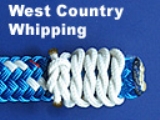
West country whipping
Encyclopedia

Technique
Half hitches are tied alternately behind and in front of the rope until the width of the band of twine approaches the diameter of the rope. A reef (square) knotReef knot
The reef knot or square knot is an ancient and simple binding knot used to secure a rope or line around an object. Although the reef knot is often seen used for tying two ropes together, it is not recommended for this purpose due to potential instability of the knot.A reef knot is formed by tying...
, or better a series of reef (square) knots, completes the whipping. If a needle is available this string of reef (square) knots can be pulled through the rope to bury the ends. Alternatively, a short bight of another rope can be laid first and used to pull the rope ends through. If the rope is a stranded rope, the ends can usually be pulled through without a needle.
Alternatives

Burning the Rope's End: The end of many synthetic ropes can be melted using heat, e.g., a flame. While this is simple and quick, it tends to fail in ropes subject to heavy use. Ideally a rope's end should be both melted (if applicable) and whipped. Burning the end of a rope can also lead to sharp edged fractures over time and when the rope is pulled under pressure though one's hands, then this might result in a hand laceration.

